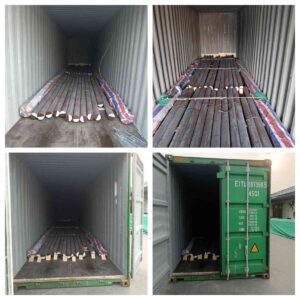Shipment of 15 Tons of 9310 Steel Bar to UAE Customer
We are pleased to announce that we have successfully shipped 15 tons of 9310 steel bar to our valued customer in the United Arab Emirates. This shipment is part of our ongoing commitment to provide high-quality products and services to our clients worldwide.
9310 steel is a low alloy steel containing nickel, chromium and molybdenum. It has high core hardness and high fatigue strength, making it suitable for a variety of applications in the aerospace, automotive, and industrial sectors. This alloy is best machined in the normalized and tempered state, which enhances its hardness, strength, and toughness.
We thank our customer for choosing us as their supplier of 9310 steel bar. We hope that this shipment will meet their expectations and help them achieve their goals. We look forward to working with them again in the future.
DESCRIPTION OF GOODS: Alloy Steel Solid Bar
| S.R. No. | Quality Standard | Steel Grade | Dimensions(mm) | Quantity | |||
| Diameter | Length | ||||||
| PCS | N.W (TONS) | G.W (TONS) | |||||
| 1 | ASTM A29 | AISI 9310 | 135 | 4000-5800 | 24 | 14.82 | 14.82 |
| TOTAL | 24 | 14.82 | 14.82 | ||||
9310 Steel Bar: A Low Alloy Steel with High Performance
Steel is one of the most widely used materials in the world, with applications ranging from construction, transportation, energy, to aerospace. However, not all steel is the same. There are different types of steel with different compositions, properties, and characteristics. One of these types is 9310 steel, a low alloy steel that contains nickel, chromium, and molybdenum. This article will introduce what 9310 steel is, what its advantages are, and how it is used in various industries.
What is 9310 steel?
9310 steel is a low alloy steel that belongs to the AISI-SAE classification system. This system categorizes steels based on their chemical composition and mechanical properties. The first digit of the four-digit number indicates the main alloying element. For example, 9xxx steels are mainly alloyed with nickel. The second digit indicates the percentage of the main alloying element. For example, 93xx steels have about 3% nickel. The last two digits indicate the carbon content. For example, 9310 steel has 0.10% carbon.
The chemical composition of 9310 steel is as follows:
– Carbon: 0.08-0.13%
– Manganese: 0.45-0.65%
– Silicon: 0.20-0.35%
– Phosphorus: max 0.025%
– Sulfur: max 0.025%
– Chromium: 1.00-1.40%
– Nickel: 3.00-3.50%
– Molybdenum: 0.08-0.15%
The addition of nickel, chromium, and molybdenum improves the hardenability, strength, toughness, and wear resistance of 9310 steel. Hardenability refers to the ability of a steel to form martensite, a hard and brittle microstructure, when quenched from high temperatures. Strength refers to the ability of a steel to resist deformation or fracture under external forces. Toughness refers to the ability of a steel to absorb energy and resist cracking or breaking under impact or shock loading. Wear resistance refers to the ability of a steel to resist abrasion or erosion by friction or contact with other materials.
What are the advantages of 9310 steel?
9310 steel has several advantages over other types of steel, such as:
– High core hardness: 9310 steel can achieve a high core hardness of up to 60 HRC (Rockwell C scale) when heat treated. This means that it can withstand high stresses and loads without deforming or failing.
– High fatigue strength: 9310 steel can endure repeated cycles of stress and strain without losing its strength or breaking. This means that it can withstand dynamic or fluctuating loads for a long time without cracking or failing.
– Good machinability: 9310 steel can be easily cut, drilled, turned, milled, or shaped by various machining processes. This means that it can be easily formed into desired shapes and sizes with minimal waste or difficulty.
– Good weldability: 9310 steel can be joined by various welding methods, such as arc welding, gas welding, or resistance welding. This means that it can be easily combined with other parts or components without compromising its integrity or performance.
– Good corrosion resistance: 9310 steel can resist rusting or deterioration by exposure to air, water, or chemicals. This means that it can maintain its appearance and functionality in harsh environments or conditions.
How is 9310 steel used?
9310 steel has a wide range of applications in various industries, such as:
– Aerospace: 9310 steel is used for making parts and components for aircraft engines, landing gears, propellers, rotors, and turbines. These parts and components require high strength, toughness, and fatigue resistance to withstand high temperatures, pressures, and speeds.
– Automotive: 9310 steel is used for making parts and components for cars, trucks, buses, motorcycles, and bicycles. These parts and components include gears, shafts, axles, bearings, pistons, rings, valves, and camshafts. These parts and components require high strength, wear resistance, and corrosion resistance to withstand friction, impact, and wear.
– Industrial: 9310 steel is used for making parts and components for machinery, equipment, tools, and devices. These parts and components include pumps, compressors, turbines, generators, motors, drills, saws,
hammers,
and wrenches. These parts and components require high strength,
toughness,
and machinability
to withstand
stress,
strain,
and vibration.
Conclusion
9310 steel is a low alloy steel that contains nickel, chromium, and molybdenum. It has high core hardness, high fatigue strength, good machinability, good weldability, and good corrosion resistance. It is used for making parts and components for various industries, such as aerospace, automotive, and industrial. 9310 steel is a versatile and reliable material that can meet the demands of different applications and environments.



